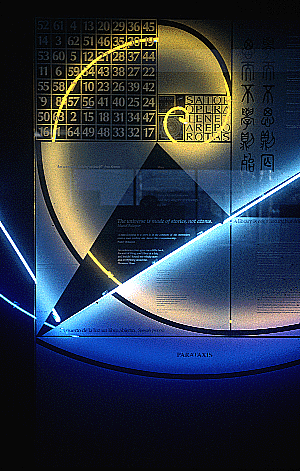Structured 8 x 8 Franklin Squares
by: Miguel Angel Amela



Definition of 8 x 8 Franklin Square
F1 F2
The well-known square F1, as well as the less familiar F2, were constructed by Benjamin Franklin.
In a letter to Peter Collinson he describes four properties of the 8 × 8 square F1 as follows:
1. The entries of every row and column add to a common sum called the magic sum.
2. In every half-row and half-column the entries add to half the magic sum.
3. The entries of the main bent diagonals and all the bent diagonals parallel to it add to the magic sum.
4. The four corner entries together with the four middle entries add to the magic sum.
Franklin mentions that the square F1 has five other curious properties but fails to list them.
According to Maya Mohsin Ahmed (
1) of the Department of Mathematics, University of California, Davis, in this work is defined 8 × 8 Franklin squares to be squares with nonnegative integer entries that have the properties (1)–(4) listed by Benjamin Franklin and the additional property that every 2 × 2 subsquare adds to one-half the magic sum. The 8 × 8 squares constructed by Franklin have this additional property (this might be one of the unstated curious properties to which Franklin was alluding in his letter). It is worth noticing that the fourth property listed by Benjamin Franklin becomes redundant with the assumption of this additional property.
In (2), Paul Pasles of the Department of Mathematical
Sciences, Villanova University, Pennsylvania says: "... readers of the
Autobiography may recall the passage wherein, bored with proceedings at
the Assembly, Franklin says he drew "magic squares or circles" to occupy his
mind. Van Doren’s Pulitzer-prize winning biography Benjamin Franklin goes
into greater detail. It includes an account of visits to the home of James
Logan, with whom Franklin perused several mathematical classics. The first of
these volumes was Frenicle de Bessy’s encyclopedic listing of the 4 by 4 magic
squares (all 880 of them!) ..."
Is of highlighting that the additional property confers to the 8 x 8 Franklin squares the structure a (alpha) of Frenicle for the 4 x 4 magic squares (3).-
Structured 8 x 8 Franklin Square
By analogy to the concept of structured magic square defined by Yuri Chebrakov of the Department of Mathematics, Technical University, St. Petersburg, for the 4 x 4 magic squares (4); we shall say that the structure of a natural 8 x 8 Franklin Square is given by the disposition of the thirty two pairs of complementary numbers of the arithmetic progression: 1–64; 2–63; 3–62; ... 32–33.-
For obtaining the structural pattern of a natural 8 x 8 Franklin Square, is sufficient to connect by lines each pair of complementary numbers, forming this structure directly in the square.-
Structures, examples, number of solutions and symmetry operations
General computer program:
* Name: F-total.exe
* Language: BASIC
* Compiler: Microsoft QuickBasic Extended v7.1 for DOS
* Size: 62.7 KB
* Strategy: Nine independent variables
* Result: 1105920 Franklin Squares
* Run time: 38 minutes in a PC with microprocessor Pentium of 2.26 GHz ( program not optimized )
Is of highlighting, that it was not programmed in function of the bent diagonals and with surprise, it was found that they are not restrictive, therefore the program not check neither; in other words, the thirty two bent diagonals are not an added complication to solve the problem.-
Orientation of the squares:
n1 n8
n57 n64
n64 > n1 < n8 < n57
Then n1, is the smaller number of the corner numbers
n1 Number of solutions
1 69120
2 68160
3 66624
4 65664
5 63648
6 62688
7 61152
8 60192
9 54624
10 53664
11 52128
12 51168
13 49152
14 48192
15 46656
16 45696
17 23424
18 22464
19 20928
20 19968
21 17952
22 16992
23 15456
24 14496
25 8928
26 7968
27 6432
28 5472
29 3456
30 2496
31 960
Total 1105920 (*)
(*) The result is the same than Daniel Schindel and collaborators of the Department of Physics and Astronomy, of the University of Manitoba in Winnipeg, Canada; obtained in about 15 hours with advanced techniques of computing, coding in C++ and running under Linux on a 2 GHz Pentium 4 machine.(5).-
According to the chosen orientation of the squares, in the 1105920 solutions were identified fifteen structures as follows:
Structure I
Structure II
Structure III
Structure IV
Structure V
Structure VI
Structure VII
Structure VIII
Structure IX
Structure X
Structure XI
Structure XII
Structure XIII
Structure XIV
Structure XV
Number of structural solutions
The run time of each one of the fifteen programs ( partially optimized ) of the structural solutions they were as follows:
Programs Number of solutions Run time (*)
F-I 368640 227
F-II 92160 36
F-III 92160 36
F-IV 53760 20
F-V 53760 20
F-VI 53760 20
F-VII 53760 20
F-VIII 53760 16
F-IX 53760 16
F-X 38400 14
F-XI 38400 14
F-XII 38400 14
F-XIII 38400 14
F-XIV 38400 14
F-XV 38400 14
------------ -----
1105920 495
(*) In seconds ( approximately the 40% of the total time, is to show the solutions in screen ).-
Symmetries of Franklin Squares
The fifteen structural patterns are symmetry operations, in consequence any Franklin Square can be transformed in other Franklin Square by means of those operations. Here some examples as follows:
The transformation of Franklin Squares with the operation III, it produces rotated isomorphic squares:
Reduced program
Coded the symmetries described by Maya Mohsin Ahmed (1), result of interchanging the alternate columns and or alternate rows: 1«3; 2«4; 5«7; 6«8 this reduced the run time to 9 seconds, producing a set of 4320 squares (1105920 / 256); the same result obtained by Daniel Schindel and collaborators in 10 minutes (5).-
The number of structural solutions of the 4320 squares is as follows:
I 1440
III 720
V 540
VI 300
VIII 420
XI 420
XIII 180
XV 300
----
4320
Observation
If not is considered the orientation of the squares, then there are eight structures:
1) I
2) II
3) III
4) IV = X
5) V = XI
6) VI = VII = XII = XIII
7) VIII = XIV
8) IX = XV

Miguel Angel Amela
General Pico - La Pampa- Argentina
( May - 2006 )
References:
(
1) Ahmed, M. M. How many squares are there, Mr Franklin? Constructing and Enumerating Franklin Squares. AmericanMathematical Monthly, 2004, 111, 394-410.-
(2) Pasles P. Benjamin Franklin Magician ? Franklin Gazette, Fall 2000.-
(3) Frenicle de Bessy. Mémoires de l’Académie Royale des Sciences, Depuis 1666, jusqu’à 1699, Tome V. Des Quarrez
de Quatre, 1729, 348-354.-
(4) Chebrakov, Y.V. Analytical Formulae and Algorithms for Constructing Magic Squares from an Arbitrary set of 16
numbers. Smarandache Notions, Book 8, 1997, 29-46.-
(5) Schindel D., Rempel M., and Loly P. Enumerating the bent diagonal squares of Dr Benjamin Franklin FRS. Proceedings
of the Royal Society A, 2006, January.-
My unpublished works:
(1) El cuadrado mágico 3 x 3 (Método de las repeticiones de los ni ); 1987.-
(2) Total de cuadrados mágicos 4 x 4 [880] (Método de las diagonales potencialmente mágicas); 1991.- (**)
(3) Cuadrados mágicos y simetría (370 geometrías simétricas diferentes del cuadrado mágico 4x4); 1996.-
(4) La ley de los cuadrados mágicos (Las constantes concéntricas); 1998.-
(5) Total de cuadrados mágicos 5 x 5 [275305224] (Método de las constantes concéntricas); 2003.-
(6) Momento de inercia de cuadrados y cubos mágicos, suma de distancias al cuadrado y números poliédricos; 2005.-
(7) Frenicle se equivocó; 2005.-
(8) Total de cuadrados mágicos 4 x 4 con un conjunto arbitrario de números sin usar la suma mágica; 2005.-
--- Redefinición de cuadrado de Franklin 8 x 8; ( en preparación ).-
(**) Published in internet (http://amela.vr9.com); 2000.- The server vr9.com closed in the year 2001.-
![]()
© 2006 Miguel Angel Amela. All rights reserved. This page cannot be copied, published or redistributed in any form without the express written consent of the author.